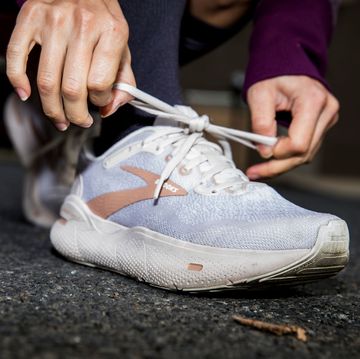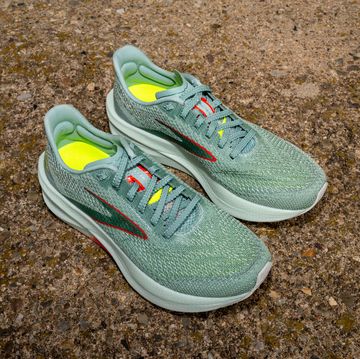The RW Takeaway: Borrowing the DNA Flash from the Hyperion Tempo, Brooks’s fastest shoe is now softer—and has more rebound.
- DNA Zero is replaced with DNA Flash, a nitrogen-infused midsole
- Why You Should Wear Trail-Specific Running Apparel
- DAA Industry Opt Out
Price: $250
Type: Competition
Offset: 8mm
Weight: 7.6 oz (unisex, men’s 9)
Available: September 1
Eyebrows were raised when we saw Brooks’s sponsored runners whirr by spectators at the Olympic Marathon Trials in Atlanta. The shoes’ upper looked the same as the Hyperion Elite—a silver crackle like a speeding comet on white, with neon yellow accents—but the midsole was noticeably beefier.
Before the Hyperion Elite’s launch on February 29, rumors were circulating that the brand was already working on the Hyperion Elite 2. Runner’s World Health & Injuries.
The Rumors Were True
Following on the heels of producing the Hyperion Elite and the Hyperion Tempo, the next logical step was to combine the best features of each shoe—the HE1’s carbon-fiber plate and Tempo’s DNA Flash midsole—to release the fastest trainer the brand had to offer.
Development on the Hyperion Elite 2 began September 2019. Scheduled to drop September 1 of this year, the shoe is the fastest product developed in the history of the company, according to senior innovation developer Bryan Bhark. But the fast track to create the fastest shoe was not without obstacles.
Seeking Validation
In 2017, Brooks’s team started working on the Elite 1, with the primary focus of forging a very lightweight and responsive racer that could rival competitors’. They started with DNA Zero, a midsole that is 45 percent lighter than the brand’s BioMoGo DNA. Constructing the shoe with DNA Flash would be the next move, but the foam wasn’t scalable at the time. It would take sampling “a couple million pairs” of the Hyperion Tempo, said Bhark over Zoom, to give the team the confidence they needed to calibrate the technology. Once the foam was validated, work on the HE2 began.
“There was a lot to learn from a manufacturing standpoint of how to utilize DNA Flash,” he said. “We wanted to make sure we weren’t going backwards from a biomechanics standpoint [and] that the shoe was going to remain stable over the marathon distance.”
More Energy Return
Marrying the DNA Flash midsole and carbon-fiber plate results in a bouncier, plusher platform with even more rebound. The support and softness the Elite 1 lacked is supplied in the Elite 2. By implementing DNA Flash, runners get the cushioning they craved.
In addition to the propulsion provided by the carbon-fiber plate, a slight curvature of the heel and toe encourages faster turnover. Similar to Saucony’s SpeedRoll and Hoka’s Meta-Rocker, this new feature is Brooks’s Rapid Roll Technology. It’s that rocking motion you get when you flex your calves while standing, rolling forward into race position.
We’ve yet to send the HE2 to the RW Shoe Lab, but according to Brooks’s measurements, the shoe is 14 percent more cushioned than the Elite 1, and has 14 percent more energy return. The foam also compresses 37 percent more than the original shoe. This displacement translates to more give and a softer, springier midsole. The stack height in the forefoot and heel is higher by 2mm.
Like its predecessor, the shoe still has a wider platform compared to its narrower competitors, i.e., Nike’s Vaporfly Next%. All About 75 Hard.
Longer Lasting
In regards to durability, many of our readers were critical of the 100-mile shelf life of the Hyperion Elite. Depending on how aggressive your gait pattern is (and if you’re willing to save this shoe when you want to set a PR), Brooks estimates the 2 can last from 200 to 400 miles before its retirement.
Because it runs unisex, sizing may fit a little loose for women runners, especially around the heel. Personally, I wished the upper was snugger during test runs. Though the paper-thin heel collar is consistent with the Elite 1, I would have preferred a more traditional collar, like the Hyperion Tempo, with this update—even if it meant the extra weight. The tongue also tended to de-center itself midrun.
With a few minor adjustments (this can be as simple as tighter lacing on the runner’s part), the Elite 2 is a shoe that will have you speeding out your door like Des Linden out of a race corral. Here’s to hoping we’ll all get that chance soon.
Amanda is a test editor at Runner’s World who has run the Boston Marathon every year since 2013; she's a former professional baker with a master’s in gastronomy and she carb-loads on snickerdoodles.















